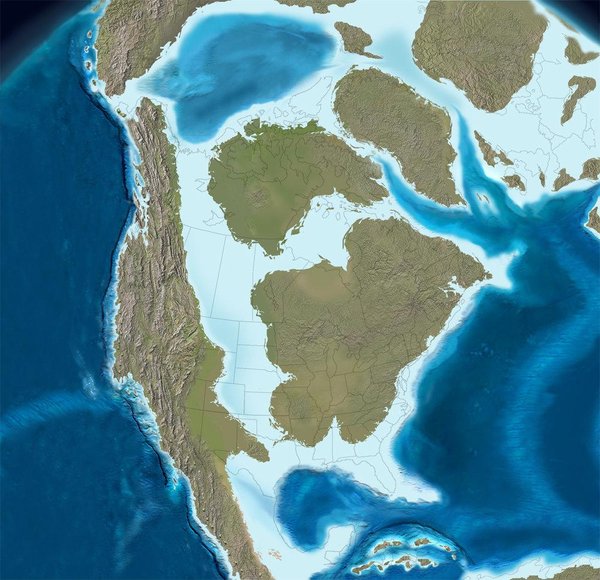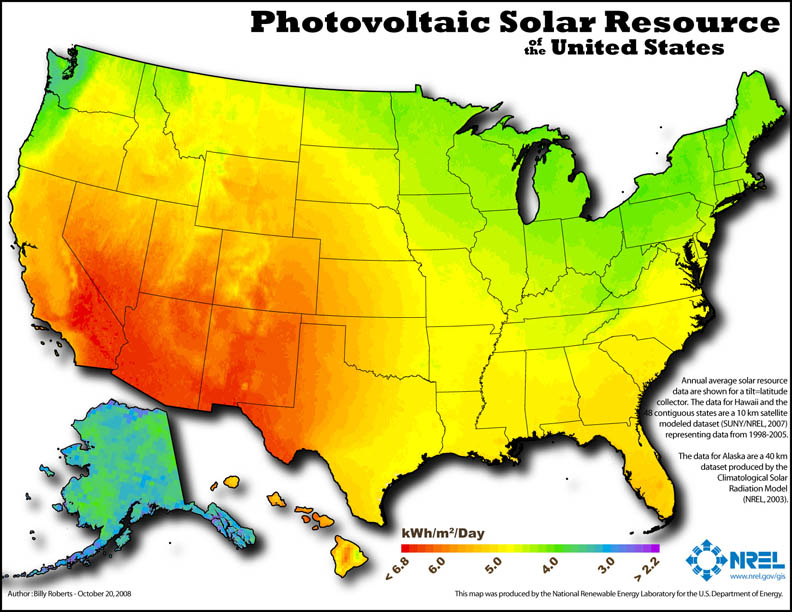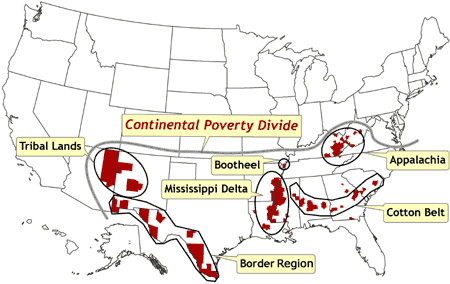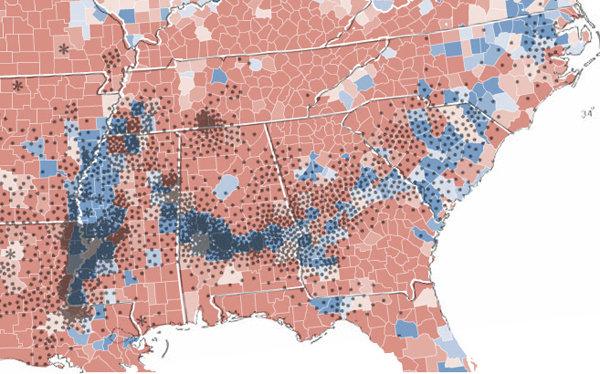 Director Lisa Biagiotti
spent two years travelling around the South
interviewing people about AIDS to make a film,
deepsouth.
She found rural AIDS is a bigger and faster-growing problem
than AIDS in center cities,
yet most health and prevention funding goes to urban areas.
The root cause seemed clear to her: poverty.
Here’s some deeper dirt (literally) on rural poverty in the U.S.,
and one thing we know can help with that: distributed solar power,
for jobs, for reduced electrical bills, and for energy independence.
What politician wouldn’t want jobs for their constituents?
Director Lisa Biagiotti
spent two years travelling around the South
interviewing people about AIDS to make a film,
deepsouth.
She found rural AIDS is a bigger and faster-growing problem
than AIDS in center cities,
yet most health and prevention funding goes to urban areas.
The root cause seemed clear to her: poverty.
Here’s some deeper dirt (literally) on rural poverty in the U.S.,
and one thing we know can help with that: distributed solar power,
for jobs, for reduced electrical bills, and for energy independence.
What politician wouldn’t want jobs for their constituents?
The director said the screening at VSU at the end of November drew more people than the day before in Little Rock. There were clearly more than 150 in the audience in Valdosta. It’s a topic very relevant to here, as Dean Poling wrote in the VDT 26 November 2012,
Organizers note that Georgia is ranked sixth highest nationally for its cumulative number of AIDS cases reported through December 2009. More than 40,000 known HIV/AIDS cases were reported in Georgia as of 2010.
The South Health District’s 10 counties, which include Lowndes and
surrounding counties, report 950 confirmed cases of HIV/AIDS, while many more are likely infected and risk becoming sick because they are not being treated. More specifically, there are about 460 reported cases in Lowndes County.
In reporting these numbers, HIV is the virus (HIV disease) and AIDS is the medical diagnosis made by a doctor of the symptoms, according to South Health District.
It’s a great movie and I highly recommend it. Director Biagiotti spent a substantial amount of her own money and two years to make this film, yet there are aspects she could only note in passing, such as incarceration. She can’t be expected to have researched every aspect; maybe somebody else can step up and help follow more threads.
The movie starts with some maps about poverty and AIDS in the South. It did not, however, look outside the South for poverty. Here are better poverty maps, from the CDC:
The Topography of Poverty in the United States: A Spatial Analysis Using County-Level Data From the Community Health Status Indicators Project,
by James B. Holt, PhD, MPA in Prev Chronic Dis 2007;4(4), October 2007.
Figure 6.
Location of counties that represent spatial clusters in which
poverty rates are at least two standard deviations higher than the
national mean. These counties correspond with areas that have been
defined for other historical, geographic, economic, and cultural
reasons (e.g., Appalachia, Mississippi Delta). The continental
poverty divide is defined as the distinctive north—south
divide across most of the United States, in which concentrations of
low poverty and spatial outliers of high poverty are confined to the
northern half, and concentrations of high poverty and spatial
outliers of low poverty are confined to the southern half. Data
source: Community Health Status Indicators (1).
The maps in the movie left out the Rio Grande Valley, the Indian lands in the southwest, and Appalachia, none of which are in the historic South. Except West Virginia, which seceded from Virginia, remember?
What is common to all these areas? Poor rural communities that have been abandoned by urban areas. Who hasn’t told a hillbilly joke about Appalachia? How many of us know anything about the Mississippi Delta except maybe the blues came from there? Holt’s Border Regions, including the Rio Grande Valley in Texas, is mostly populated by Hispanics, who are currently maligned as illegal immigrants, whether they are or not. All most people know about Indian Tribal Lands is they’re rife with unemployment and alcoholism.
Below the maps in the movie, there’s another level: the soils. The movie did not remark on that arc across Mississippi, Alabama, and Georgia into the Carolinas. That’s the Black Belt, distinctive because of its black dirt, which is why cotton was so popular there. Dirt that originated about 75 million years ago, when the Cretaceous period ended with a meteorite that killed a lot of plankton right off what was then the coastline of what would become the U.S. southeast.

Map found in
Paleo-politics: The really long view,
by Will Femia, the MaddowBlog, 24 August 2012.
The same meteorite that ended the dinosaurs was the origin of the black belt soils across the fall line in the southeast. Those soils were good for growing cotton, which was worked by slaves, whose descendants became free blacks who nowadays mostly vote Democratic, as in this map comparing cotton growing in 1860 to presidential election results in 2008:
Soils also explain much of the history of the Mississippi Delta, which you can clearly see in the same map above.
So far, this looks like a dirt-deep version of what deepsouth the movie said. Except it doesn’t stop at political events of a few hundred years ago. Stopping with cultural origins specific to the Southeast is too close to saying there’s nothing we can do because nothing has changed in hundreds of years. (Once again, this is not a criticism of the filmmaker, who already did something nobody else has done, at considerable expense to herself in time and money.) Looking at soils takes away that easy political explanation of poverty. Actually, there is something we can do, and it’s also related to physical geography.
Soils of different origin also explain much about the Rio Grande Valley, which is inhabited mostly by people who had nothing to do with the Old South: it’s a fertile river valley through a desert. Geography also explains Appalachia: settlers from the borderlands in the north of England, the south of Scotland, and the northeast of Ireland went there because the mountains and valleys resembled their homelands. The Indian reservations are at least partly the historic homelands of certain tribes, which they liked because of the geography.
Physical geography is to some sense destiny. But we can overcome it if we understand it, which requires looking beyond easy historical answers. Let’s look at physical geography for at least one way to alleviate rural poverty.
Compare this map of U.S. solar photovoltaic insolation:

NREL: Photovoltaic Solar Resource of the United States
Hm, lots of sunshine in the Black Belt, the Rio Grand Valley, and Tribal
Lands!
Not quite as much in Appalachia, but way more than in Germany,
the world leader in solar power. Rural solar power can help fight rural
poverty, the root cause of the rural HIV epidemic.
 It will bring jobs
in transportation, installation, and research.
It will reduce poor people’s electric bills, especially if combined
with weatherizing for energy efficiency, like
Houston has been doing, according to former Mayor Bill White:
It will bring jobs
in transportation, installation, and research.
It will reduce poor people’s electric bills, especially if combined
with weatherizing for energy efficiency, like
Houston has been doing, according to former Mayor Bill White:
So in Houston, we gave everybody in a neighborhood a one-page form that said “Yes” or “No.” For everybody who
wanted it, a crew would come in and pressurize the house, seal the leaks, put or replace insulation in the attic if it was insufficient, replace light bulbs with energy-efficient light bulbs, those types of things. We could do one house in about 2 hours and 10 minutes. In the neighborhoods where we did this, we brought down the average utility bill for all who participated by 10 to 20 percent. We scaled up, trained crews, created jobs, and had certifications and quality control, for a little more than $1,000 per house, versus ! $8,000 for the traditional weatherization program. That’s the type of program we need throughout the country, especially in middle-class neighborhoods built from 1940 to 1970.
Georgia’s 1973 Territoriality Law holds solar back in Georgia by making it hard for homeowners and businesses to finance solar installations. Meanwhile, Southern Company and Georgia Power don’t want to change that law. Instead they are wasting a lot of ratepayer money in rate hikes for building new nukes and natural gas plants.
A company called Georgia Solar Utilities (GaSU) wants to build a solar utility, and has gotten the Georgia Public Service Commission to say that’s a good idea. The legislature still must approve GaSU’s plan, which would add another utility to the utilities already in the 1973 law. A solar utility, which would issue bonds to finance a few huge solar installations. The advantage of such a utility is precisely that it aggregates the buying power of the entire state so as to keep bond coupon rates down. But that’s one way to spell “monopoly”. A monopoly that does nothing about jobs in the Black Belt or most of the rest of rural Georgia. GaSU says that a solar utility would drive down electrical costs for everyone. Perhaps so, eventually. And a few big solar plants wouldn’t hurt.
But a centralized solar utility does nothing for jobs in most poor rural areas. We need widely distributed solar across the entire southeast and in the other areas of high poverty: for jobs, for reduced electrical bills, and for energy independence for the whole region. We need to be sure any legislative fix to the 1973 law for GaSU (or any other reason) also fixes it so everyone can readily get financing for rooftop solar power. What legislators want to say they’re opposed to jobs for their constituents?
-jsq
Short Link:

